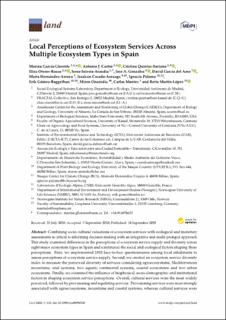Local Perceptions of Ecosystem Services Across Multiple Ecosystem Types in Spain
García-Llorente, Marina; Castro, Antonio J.; Quintas-Soriano, Cristina; Oteros-Rozas, Elisa; Iniesta-Arandia, Irene; González, José A.; García Del Amo, David; Hernández-Arroyo, Marta; Casado-Arzuaga, Izaskun; Palomo, Ignacio; Gomez-Baggethun, Erik; Onaindia, Miren; Montes, Carlos; Martín-López, Berta
Peer reviewed, Journal article
Published version

Åpne
Permanent lenke
https://hdl.handle.net/11250/2685628Utgivelsesdato
2020Metadata
Vis full innførselSamlinger
- Publikasjoner fra CRIStin - NINA [2364]
- Scientific publications [1392]
Originalversjon
10.3390/land9090330Sammendrag
ecosystem service diversity; governance; local communities; place-based approach; socio-cultural valuation; social perception Combining socio-cultural valuations of ecosystem services with ecological and monetary
assessments is critical to informing decision making with an integrative and multi-pronged approach.
This study examined di erences in the perceptions of ecosystem service supply and diversity across
eight major ecosystem types in Spain and scrutinized the social and ecological factors shaping these
perceptions. First, we implemented 1932 face-to-face questionnaires among local inhabitants to
assess perceptions of ecosystem service supply. Second, we created an ecosystem service diversity
index to measure the perceived diversity of services considering agroecosystems, Mediterranean
mountains, arid systems, two aquatic continental systems, coastal ecosystems and two urban
ecosystems. Finally, we examined the influence of biophysical, socio-demographic and institutional
factors in shaping ecosystem service perceptions. Overall, cultural services were the most widely
perceived, followed by provisioning and regulating services. Provisioning services were most strongly
associated with agroecosystems, mountains and coastal systems, whereas cultural services wereassociated with urban ecosystems and regulating services were specifically linked with agroecosystems,
mountains and urban recreational areas. The highest service diversity index values corresponded to
agroecosystems, mountains and wetlands. Our results also showed that socio-demographic factors,
such as place of origin (urban vs. rural) and educational level, as well as institutional factors, such as
management and access regimes, shaped the perception of ecosystem services.
